Day 1 - Distance Task
If it was easy it wouldn’t be called fishing, it would be called
catching. Or something like that. Which pretty much sums up Saturday's
distance task. Cooler temperatures, a general hazy grey cloud cover and
southwest breeze promised for a tough day. We had a good turnout with
10 teams showing up from across California from LA all the way up to
Oregon. The pilots meeting kicked off at 10am and the new distance course
was laid out.
There are three main XC venues in California held each
year at Montague, Davis and Cal Valley with Davis being different from
the other two in that we are using a proscribed course with the order
of the course turn points and direction set. At 26 miles our distance
course is also the shortest.
I really like the variety of these three
different XC locations. Montague is king of the hill with a beautiful
course in the Shasta Valley up near the California/Oregon border. Cal
valley is in a desolate area of the coastal foothills of south central
California about 40 miles east of Santa Maria. It's course is laid out
over high desert tumbleweed terrain surrounding a dry soda lakebed and
is known for it's scary monster thermals. Davis is absolutely flat land
with straight roads, crops and orchards, a patchwork of brown and green.
All three are challenging in their own way and we left coast fliers are
lucky to have this variety.
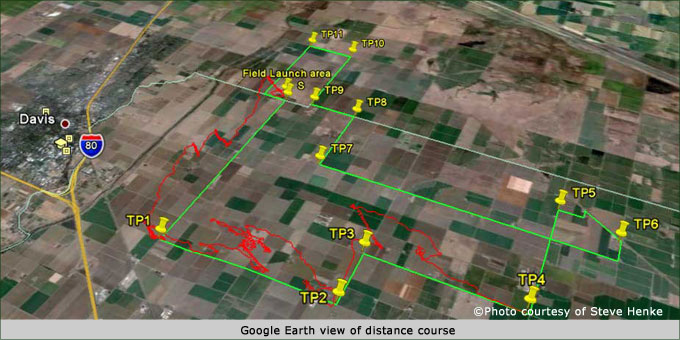
For this year Dudley Dufort offered me the chance to co-CD the event
and I gladly accepted so I drove around and spent a little time laying
out a new course to try and avoid the dirt roads we've had problems
with in the past. Dirt roads can be hazardous to your XC racers'
health when you are specked out cruising along and dust from a vehicle
in front of you suddenly renders your sailplane invisible. Its surprising
how a small amount of dust in the air can cause this problem. The
entire 26 mile Davis course is paved except for a few hundred yards
of gravel road just before TP8. That’s about the best we could do without
doubling back on any previously traveled part of the route. We also decided that
there would be no time limit for Distance. Winches would be shut down at 3pm
and as long as you were in the air at 3pm you could fly as long as possible.
No limit on flying time could potentially lead to flights in the category of "epic".
By noon on Saturday no teams had managed to get out on course and it
was starting to look pretty grim. Much hand wringing, wailing and gnashing
of teeth ensued. A halo formed around the blurred out sun and the amateur
weathermen among our ranks confidently predicted rain to add to our
misery. One thing I do notice when things occasionally get bleak during
these XC adventures is it really brings out the "glass is half full/half empty" aspects of the various personalities.
Maybe someday I'll be able to join the ranks of the "glass half full" strong
silent types but on this particular day I was doing my fair share of moaning
along with the rest of our sorry lot. After repeated launches and what felt like
hours of listening to the dreaded buzz of dead air from our Vario my teammate
Bill and I got so frustrated we decided to hell with it, we're heading out no
matter what. We grounded our racer and launched Bill's
Ava Pro, piled into the truck and moved out. All of 0.6 miles. Still,
it was miles on the score sheet and we were now officially in first
place. That was the first time I've flown XC with a TD ship and no
Vario. The Ava is a fine floater and can penetrate wind even with such
a light wing loading but right off I could see a problem. It is hard
to visually read lift from a moving vehicle so knowing when to stop
and thermal can be a problem. I think for effective XC flying a Vario
is more than just a luxury, its a necessity. Our second attempt with
me at the controls resulted in zero miles and our third attempt with
Bill piloting got us 1.2 miles down the course.
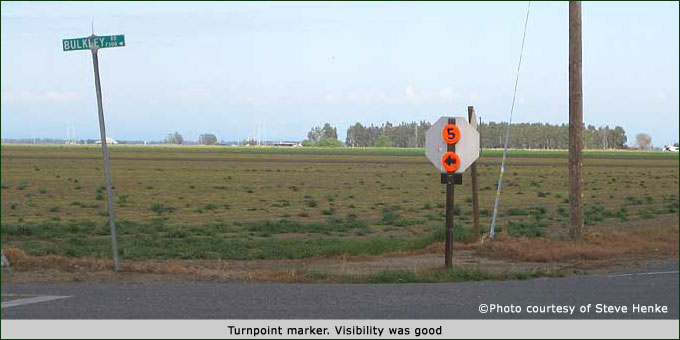 By then it was 1pm
and lift was starting to break loose so we launched our racer, found
a decent but fast moving thermal on the south end of the field and
managed about 450 meters before making the dash thru the Eucalyptus
tree tunnel at the field entrance and went for it. Once off the field
things seemed to improve and we found weak widely spaced thermals to
about 400-500 meters, enough to keep us moving west flying crosswind
in the south wind. Rounding TP1 things changed and we were now flying
into a south headwind quartering from the west. Headwind flying in
XC is challenging but Dudley proved at last fall's Cal Valley event
that patience and persistence can win the day so we kept chasing thermals
downwind slowly netting distance in the process in a sort of ratcheting
stair-stepping fashion. Proceeding in this way at about 5-10mph ground
speed it seemed to take forever. Headwind flying like this can be hard
on the nerves. Rounding TP2 we suddenly had a tail wind as the wind
was more westerly now and at 50mph we barely managed to get in front
of our racer over the 1 mile between TP2 and TP3. After TP3 it was
more of the same hard slog into the wind but suddenly it became warm
and the wind died a little, the sun shown a little brighter and a large
lift cycle boosted us to 600 meters and raised our hopes we could make
it to the old Mill at TP6 at the most southerly part of the course
and ride a tail wind most of the way home. But, not to be and things
cooled down and the wind came back with a vengeance feeding into the
large lift cycle we left behind. Nearing TP4 with our plane only 30ft
above our heads directly over the road I briefly considered trying
to slope soar it off the large Plexiglas windscreen mounted above the
cab of my truck but the large turbulence set off by our vehicle tossed
the racer up on a wing tip and nixed that stupid idea. After nearly
2 hours of flying we landed a few yards short of TP4 for a total of
10.5 (brutal) miles. John Ellias made it to TP6 but ran out of lift
and landed there with a total of 13.8 miles for the win. 7 of the 10
teams made it off field and onto the course. It was a tough day.
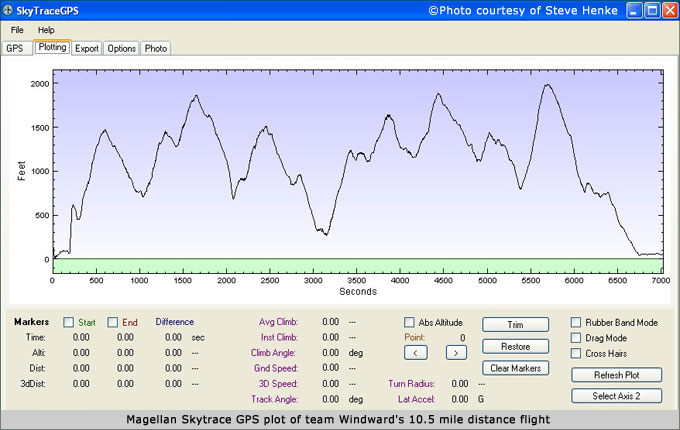 Day 2 - Speed Task
I'm sure I'm not the only pilot who went home Saturday evening and
prayed to the weather gods. But to no avail. When I arrived at the
field Sunday morning it was winter cold, same grey sky, same halo around
a veiled sun, same chorus of moaning from the "half-empty" contingent, same 5-10 southerly wind but now with a line of clouds in the distance. We of the half-empty clan were thinking rain and after Saturday's events not hopeful for a good ending to the weekend. March is such a crapshoot for an XC event. But clouds with the instability they bring can also mean the dead flat conditions can get broken up.
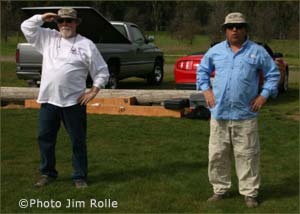 Today
was Speed task on a proscribed 16 mile loop. As a change from previous
years we decided to do a remote start and finish. This is because a
finish line at our field is somewhat hazardous with large trees and
difficult parking. For this new speed course pilots would need to winch
launch, get off the field and fly 1.5 miles to the starting gate. This
was not as bad as it seemed as conditions between the field and start
were consistently better than on the field itself and there are good
opportunities to tank up between the field and start. Also, having
the remote start and finish at the same corner on the 16 mile loop
I hoped it would be possible to cross the finish at speed, zoom up,
find another thermal to tank up then head back out on course for a
second attempt without having to land, get back to the field and winch
launch again. A lot of time can be saved and it may even be possible
to get three attempts on a single flight in the right conditions. As
it turns out the winning team did just this to their advantage in getting
the win completing two laps of the course. Today
was Speed task on a proscribed 16 mile loop. As a change from previous
years we decided to do a remote start and finish. This is because a
finish line at our field is somewhat hazardous with large trees and
difficult parking. For this new speed course pilots would need to winch
launch, get off the field and fly 1.5 miles to the starting gate. This
was not as bad as it seemed as conditions between the field and start
were consistently better than on the field itself and there are good
opportunities to tank up between the field and start. Also, having
the remote start and finish at the same corner on the 16 mile loop
I hoped it would be possible to cross the finish at speed, zoom up,
find another thermal to tank up then head back out on course for a
second attempt without having to land, get back to the field and winch
launch again. A lot of time can be saved and it may even be possible
to get three attempts on a single flight in the right conditions. As
it turns out the winning team did just this to their advantage in getting
the win completing two laps of the course.
Like Saturday conditions were slow to develop and it
was 1 pm before teams started finding enough lift on the field to make
an attempt. We decided to move the cutoff time from 3pm to 4pm due
to the late start which turned out to be a good move. It also was starting
to warm up and the wind was dying down. What in the morning had seemed
hopeless was now looking much better. Seven teams made it off the field
and onto the course. My team (Windward) got off field about 1:30 and
made it to the remote start but we ran out of luck at about a mile
further and landed out. On our second attempt we arrived at the start just as John Ellias' team (Screaming Eagles) arrived at the finish so I knew conditions had improved dramatically. The clouds had brought instability, there was blue sky, the wind had died and all were happy. I guess miracles do happen and I don't remember ever seeing such a dramatic change in weather over such a short time span at our field. From winter to spring in just a few hours.
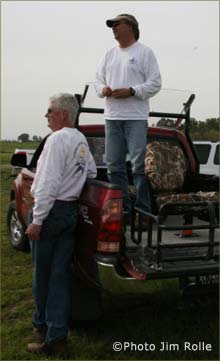 Ellias had left before our first attempt so I knew it had been a long
flight. Sure enough, he searched, found a thermal, then joined our
thermal for a time, then headed back to the start to re-start his clock
for his second attempt (smart move) . Then Rich Spicer's team (Atomic
Fireball) crossed the finish so the race was on. Rich landed so I figured
he must have had a pretty good lap time. In speed with the FAI scoring
we use, once you have one lap in the bag you can go all out on the
second one knowing you wont get killed in the scoring. If any team
finishes the course the rest of the teams must finish or take a heavy
score penalty. The finishing team with the fastest time is awarded
1000 points. Remaining teams that finish are scored using the formula
700 + (winning team time/team time X 300). If a winning team completed
the course in one hour and another team completed it in 10 hours the
worst the slower team could score would still be over 700 points. Meanwhile
teams that donít finish are scored using the formula (distance flown/course distance X 700). The best a team that does not finish the course can score is still under 700 points. This is a good system as it narrows the point spread between slow teams and fast teams (think MXC vs. SagittaXC).
One highlight of our second flight was when we flew into a thermal occupied by a pair of red tail hawks. With one hawk above our plane and one below it soon became apparent these were a mating pair when the male, flying top cover, repeatedly dive bombed us (donít worry Greg, no talon holes in good ole #3). Unfortunately my team fizzled out again about a mile past TP1. Ellias blasted by us as we were packing up on his way to the win. Four teams finished the course which pretty much ended my team's chance for a top three overall trophy. Ellias finished it twice with a 53 minute fast lap time to take the win. He even landed back on the field, another masterful display of flying skill. Thermals were stronger in the nice conditions with teams reporting heights of 700-800 meters. All in all a very nice finish to a challenging weekend. Ellias had left before our first attempt so I knew it had been a long
flight. Sure enough, he searched, found a thermal, then joined our
thermal for a time, then headed back to the start to re-start his clock
for his second attempt (smart move) . Then Rich Spicer's team (Atomic
Fireball) crossed the finish so the race was on. Rich landed so I figured
he must have had a pretty good lap time. In speed with the FAI scoring
we use, once you have one lap in the bag you can go all out on the
second one knowing you wont get killed in the scoring. If any team
finishes the course the rest of the teams must finish or take a heavy
score penalty. The finishing team with the fastest time is awarded
1000 points. Remaining teams that finish are scored using the formula
700 + (winning team time/team time X 300). If a winning team completed
the course in one hour and another team completed it in 10 hours the
worst the slower team could score would still be over 700 points. Meanwhile
teams that donít finish are scored using the formula (distance flown/course distance X 700). The best a team that does not finish the course can score is still under 700 points. This is a good system as it narrows the point spread between slow teams and fast teams (think MXC vs. SagittaXC).
One highlight of our second flight was when we flew into a thermal occupied by a pair of red tail hawks. With one hawk above our plane and one below it soon became apparent these were a mating pair when the male, flying top cover, repeatedly dive bombed us (donít worry Greg, no talon holes in good ole #3). Unfortunately my team fizzled out again about a mile past TP1. Ellias blasted by us as we were packing up on his way to the win. Four teams finished the course which pretty much ended my team's chance for a top three overall trophy. Ellias finished it twice with a 53 minute fast lap time to take the win. He even landed back on the field, another masterful display of flying skill. Thermals were stronger in the nice conditions with teams reporting heights of 700-800 meters. All in all a very nice finish to a challenging weekend.
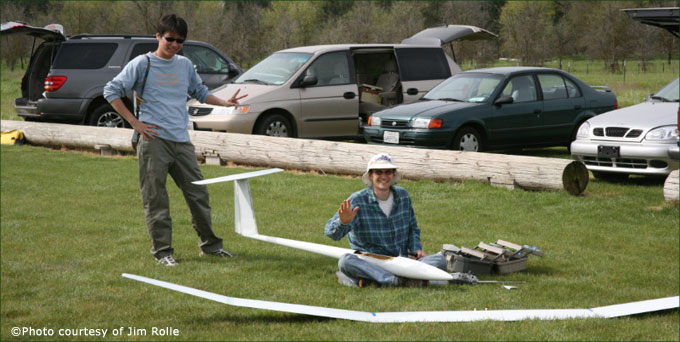 I had planned to take more pictures and video but didn’t manage
much. The video was taken on day 2. I would
also like to thank Mike Clancy for doing a great job as driver and
Greg Norsworthy for his continued loan of trusty #3, team Windward
would not exist right now without it. She ain’t purty but she
sure flies well.
Some notes and observations
I've been flying XC for over 10 years now but have never been involved
with running an event and (like most people) would much prefer to
kick back as a participant. But there are a few ideas I wanted to
try for our Davis contest and Dudley let me run with it.
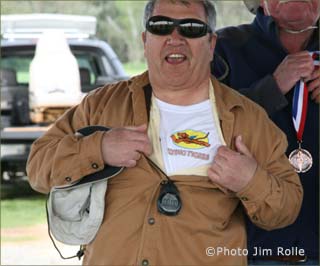 Plastic laminating the maps back to back worked out well and makes it easier
for drivers as they fumble around for papers, pens, stop watches, trip odometers,
etc. I forgot to tell the teams at the pilots meeting that I wanted them back
so we could re-use them but by Sunday afternoon figured what the hell, keep em.
Use them for placemats if you like. Come to more Davis events and you can end
up with a whole set! Plastic laminating the maps back to back worked out well and makes it easier
for drivers as they fumble around for papers, pens, stop watches, trip odometers,
etc. I forgot to tell the teams at the pilots meeting that I wanted them back
so we could re-use them but by Sunday afternoon figured what the hell, keep em.
Use them for placemats if you like. Come to more Davis events and you can end
up with a whole set!
The fluorescent orange TP markers worked out well. Using two of them (one with
a number and one with an arrow) made them very visible. No team complained of
not seeing TP markers.
The score sheets need some work. Also I think putting both distance and speed
on one sheet front and back might be better.
Providing clipboards to all teams also made things a little easier
for the drivers. That’s a keeper.
I didn’t do so well at spelling out the info at the pilots meeting. I think
writing it all down on paper and providing the teams with a handout would help.
GPS.... I think most of the teams now have GPS. GPS is the future of XC and adds
a whole new dimension. I just love playing around with the flight plots on Google
Earth. One side effect of GPS however.... its pretty tough to stick to the tall
tales and fish stories when the facts are staring you in the face. I typed this
report up before viewing my distance flight and had to laugh as I "re-edited" a
few minor errors in my report to make reality jibe with memory.
See you at the Soaring Safari!! wonder what course Dudley has for us this time....
Steve Henke |

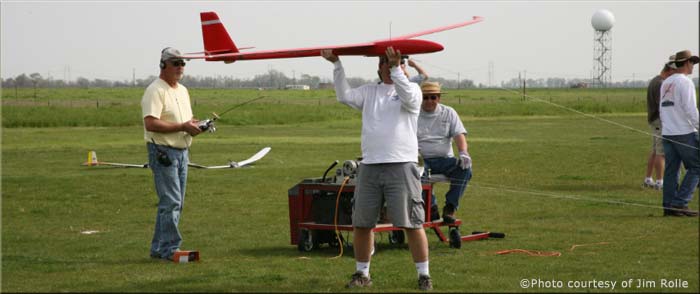




 Today
was Speed task on a proscribed 16 mile loop. As a change from previous
years we decided to do a remote start and finish. This is because a
finish line at our field is somewhat hazardous with large trees and
difficult parking. For this new speed course pilots would need to winch
launch, get off the field and fly 1.5 miles to the starting gate. This
was not as bad as it seemed as conditions between the field and start
were consistently better than on the field itself and there are good
opportunities to tank up between the field and start. Also, having
the remote start and finish at the same corner on the 16 mile loop
I hoped it would be possible to cross the finish at speed, zoom up,
find another thermal to tank up then head back out on course for a
second attempt without having to land, get back to the field and winch
launch again. A lot of time can be saved and it may even be possible
to get three attempts on a single flight in the right conditions. As
it turns out the winning team did just this to their advantage in getting
the win completing two laps of the course.
Today
was Speed task on a proscribed 16 mile loop. As a change from previous
years we decided to do a remote start and finish. This is because a
finish line at our field is somewhat hazardous with large trees and
difficult parking. For this new speed course pilots would need to winch
launch, get off the field and fly 1.5 miles to the starting gate. This
was not as bad as it seemed as conditions between the field and start
were consistently better than on the field itself and there are good
opportunities to tank up between the field and start. Also, having
the remote start and finish at the same corner on the 16 mile loop
I hoped it would be possible to cross the finish at speed, zoom up,
find another thermal to tank up then head back out on course for a
second attempt without having to land, get back to the field and winch
launch again. A lot of time can be saved and it may even be possible
to get three attempts on a single flight in the right conditions. As
it turns out the winning team did just this to their advantage in getting
the win completing two laps of the course. Ellias had left before our first attempt so I knew it had been a long
flight. Sure enough, he searched, found a thermal, then joined our
thermal for a time, then headed back to the start to re-start his clock
for his second attempt (smart move) . Then Rich Spicer's team (Atomic
Fireball) crossed the finish so the race was on. Rich landed so I figured
he must have had a pretty good lap time. In speed with the FAI scoring
we use, once you have one lap in the bag you can go all out on the
second one knowing you wont get killed in the scoring. If any team
finishes the course the rest of the teams must finish or take a heavy
score penalty. The finishing team with the fastest time is awarded
1000 points. Remaining teams that finish are scored using the formula
700 + (winning team time/team time X 300). If a winning team completed
the course in one hour and another team completed it in 10 hours the
worst the slower team could score would still be over 700 points. Meanwhile
teams that donít finish are scored using the formula (distance flown/course distance X 700). The best a team that does not finish the course can score is still under 700 points. This is a good system as it narrows the point spread between slow teams and fast teams (think MXC vs. SagittaXC).
One highlight of our second flight was when we flew into a thermal occupied by a pair of red tail hawks. With one hawk above our plane and one below it soon became apparent these were a mating pair when the male, flying top cover, repeatedly dive bombed us (donít worry Greg, no talon holes in good ole #3). Unfortunately my team fizzled out again about a mile past TP1. Ellias blasted by us as we were packing up on his way to the win. Four teams finished the course which pretty much ended my team's chance for a top three overall trophy. Ellias finished it twice with a 53 minute fast lap time to take the win. He even landed back on the field, another masterful display of flying skill. Thermals were stronger in the nice conditions with teams reporting heights of 700-800 meters. All in all a very nice finish to a challenging weekend.
Ellias had left before our first attempt so I knew it had been a long
flight. Sure enough, he searched, found a thermal, then joined our
thermal for a time, then headed back to the start to re-start his clock
for his second attempt (smart move) . Then Rich Spicer's team (Atomic
Fireball) crossed the finish so the race was on. Rich landed so I figured
he must have had a pretty good lap time. In speed with the FAI scoring
we use, once you have one lap in the bag you can go all out on the
second one knowing you wont get killed in the scoring. If any team
finishes the course the rest of the teams must finish or take a heavy
score penalty. The finishing team with the fastest time is awarded
1000 points. Remaining teams that finish are scored using the formula
700 + (winning team time/team time X 300). If a winning team completed
the course in one hour and another team completed it in 10 hours the
worst the slower team could score would still be over 700 points. Meanwhile
teams that donít finish are scored using the formula (distance flown/course distance X 700). The best a team that does not finish the course can score is still under 700 points. This is a good system as it narrows the point spread between slow teams and fast teams (think MXC vs. SagittaXC).
One highlight of our second flight was when we flew into a thermal occupied by a pair of red tail hawks. With one hawk above our plane and one below it soon became apparent these were a mating pair when the male, flying top cover, repeatedly dive bombed us (donít worry Greg, no talon holes in good ole #3). Unfortunately my team fizzled out again about a mile past TP1. Ellias blasted by us as we were packing up on his way to the win. Four teams finished the course which pretty much ended my team's chance for a top three overall trophy. Ellias finished it twice with a 53 minute fast lap time to take the win. He even landed back on the field, another masterful display of flying skill. Thermals were stronger in the nice conditions with teams reporting heights of 700-800 meters. All in all a very nice finish to a challenging weekend. Plastic laminating the maps back to back worked out well and makes it easier
for drivers as they fumble around for papers, pens, stop watches, trip odometers,
etc. I forgot to tell the teams at the pilots meeting that I wanted them back
so we could re-use them but by Sunday afternoon figured what the hell, keep em.
Use them for placemats if you like. Come to more Davis events and you can end
up with a whole set!
Plastic laminating the maps back to back worked out well and makes it easier
for drivers as they fumble around for papers, pens, stop watches, trip odometers,
etc. I forgot to tell the teams at the pilots meeting that I wanted them back
so we could re-use them but by Sunday afternoon figured what the hell, keep em.
Use them for placemats if you like. Come to more Davis events and you can end
up with a whole set!